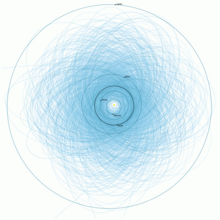Sentry (monitoring system)
Since 2002, Sentry has been a highly automated impact prediction system that continually monitors the most current asteroid catalog for possibilities of future impact with Earth over the next 100+ years.[1] Whenever a potential impact is detected it will be analyzed and the results immediately published by the Near Earth Object Program.[1]
However, several weeks of optical data are not enough to conclusively identify an impact years in the future.[2] By contrast, eliminating an entry on the risk page is a negative prediction; a prediction of where it will not be.[2] Scientists warn against worrying about the possibility of impact with an object based on only a few weeks of optical data that show a possible Earth encounter years from now.[2]
Contents
1 Sentry Risk Table
2 See Also
3 References
4 External links
Sentry Risk Table

Plot of orbits of known potentially hazardous asteroids
The Impact Risk page lists a number of lost objects that are, for all practical purposes, permanent residents of the risk page; their removal may depend upon a serendipitous rediscovery.[3]1997 XR2 was serendipitously rediscovered in 2006 after being lost for more than 8 years. 2004 BX159 was determined to be a harmless main belt asteroid in 2014. 2010 GZ60 with an almost worthless 1.3 day observation arc missed 4 virtual impactor dates in 2017–2018.[4] Some objects on the Sentry Risk Table, such as 2000 SG344, might even be man-made.
2010 RF12 is the asteroid with greatest probability (5%) of impacting Earth, but is only ~7 meters in diameter. Numbered notable objects with observation arcs of several years include: (29075) 1950 DA, 99942 Apophis, 101955 Bennu, and (410777) 2009 FD.[1] Notable asteroids removed from Sentry in the last few years include (most recently removed listed first): 2017 XO2, 1994 WR12, 2007 VK184, 2013 BP73, 2008 CK70, 2013 TV135, 2011 BT15, 367943 Duende, and 2011 AG5.
The diameter of most near-Earth asteroids that have not been studied by radar or infrared can generally only be estimated within about a factor of 2 based on the asteroid's absolute magnitude (H).[1] Their mass, consequently, is uncertain by about a factor of 10. For near-Earth asteroids without a well-determined diameter, Sentry assumes a generic albedo of 0.15. More than two dozen known asteroids have higher than a one in a million chance of impacting into Earth within the next 100 years.[5]
In August 2013, the Sentry Risk Table started using planetary ephemeris (DE431) for all NEO orbit determinations.[6] DE431 (JPL small-body perturber ephemeris: SB431-BIG16) better models the gravitational perturbations of the planets and includes the 16 most massive main-belt asteroids.[6]
JPL launched major changes to the website in February 2017 and re-directed the classic page on 10 April 2017.
As of January 2018[update] there are roughly 818 near-Earth asteroids listed on the risk table[1] and roughly 2097 asteroids have been removed from the risk table since it launched in 2002.[7]
See Also
- Asteroid impact prediction
- Impact event
References
^ abcde "Sentry Risk Table". NASA/JPL Near-Earth Object Program Office. Retrieved 2017-04-13..mw-parser-output cite.citation{font-style:inherit}.mw-parser-output q{quotes:"""""""'""'"}.mw-parser-output code.cs1-code{color:inherit;background:inherit;border:inherit;padding:inherit}.mw-parser-output .cs1-lock-free a{background:url("//upload.wikimedia.org/wikipedia/commons/thumb/6/65/Lock-green.svg/9px-Lock-green.svg.png")no-repeat;background-position:right .1em center}.mw-parser-output .cs1-lock-limited a,.mw-parser-output .cs1-lock-registration a{background:url("//upload.wikimedia.org/wikipedia/commons/thumb/d/d6/Lock-gray-alt-2.svg/9px-Lock-gray-alt-2.svg.png")no-repeat;background-position:right .1em center}.mw-parser-output .cs1-lock-subscription a{background:url("//upload.wikimedia.org/wikipedia/commons/thumb/a/aa/Lock-red-alt-2.svg/9px-Lock-red-alt-2.svg.png")no-repeat;background-position:right .1em center}.mw-parser-output .cs1-subscription,.mw-parser-output .cs1-registration{color:#555}.mw-parser-output .cs1-subscription span,.mw-parser-output .cs1-registration span{border-bottom:1px dotted;cursor:help}.mw-parser-output .cs1-hidden-error{display:none;font-size:100%}.mw-parser-output .cs1-visible-error{font-size:100%}.mw-parser-output .cs1-subscription,.mw-parser-output .cs1-registration,.mw-parser-output .cs1-format{font-size:95%}.mw-parser-output .cs1-kern-left,.mw-parser-output .cs1-kern-wl-left{padding-left:0.2em}.mw-parser-output .cs1-kern-right,.mw-parser-output .cs1-kern-wl-right{padding-right:0.2em}
^ abc Jon Giorgini (30 July 2002). "Understanding Risk Pages". Columbine, Inc. (hohmanntransfer). Retrieved 2011-11-21.
^ "IMPACT RISK ASSESSMENT: AN INTRODUCTION". NASA/JPL Near-Earth Object Program Office. 31 Aug 2005. Retrieved 2011-10-14.
^ 2010 GZ60 -- Earth Impact Risk Summary "Archived copy". Archived from the original on 4 May 2017. Retrieved 2018-03-16.CS1 maint: Archived copy as title (link) CS1 maint: BOT: original-url status unknown (link)
^ Donald K. Yeomans (9 February 2013). "Beware of Errant Asteroids". New York Times. Retrieved 10 February 2013.
^ ab "Sentry Notes". NASA/JPL Near-Earth Object Program Office. 2013-08-12. Retrieved 2017-04-13.
^ "Removed Objects". NASA/JPL Near-Earth Object Program Office. Archived from the original on 2017-02-25. Retrieved 2017-02-16.
External links
- Sentry: Introduction
- Sentry: Impact Risk Data table
- NEODyS CLOMON2
- List of objects for which all previously detected potential impacts have been eliminated
Asteroid Hazards, Part 3: Finding the Path – Minor Planet Center on YouTube